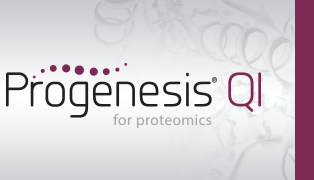How does peptide ion deconvolution work?
"Peptide ions" correspond to isotopic clusters derived from a single charge state of a given peptide. In Progenesis QI for proteomics, deconvolution refers to the process of grouping together individual peptide ions that are calculated to be from the same peptide.
Deconvolution of peptide ions into peptides is performed both before and after identifications have been found. The deconvolution process is also used to improve the identification data in Progenesis. This FAQ explains how peptide ion deconvolution is used in your workflow.
Charge state deconvolution
Grouping by charge state is the foundation of deconvolution in Progenesis QI for proteomics. Given one peptide ion (a charge state of a peptide consisting of a series of isotopic peaks), it is possible to calculate where other charge states would be present in the m/z profile, using the known m/z value and assuming ionisation by H+ to derive the neutral mass of the peptide.
This allows the software to group together peptide ions with different charges and consider the collection to be the same "peptide".
Note that the software performs an additional check, ensuring that only ions with the same retention time can be deconvoluted to form a peptide. Whilst this may seem obvious, it's worth noting as Progenesis QI for proteomics shows you peptide ions spanning the full retention time range of your experiment.
Using this charge state deconvolution of peptide ions (having the same retention time), peptide data can be generated before any identification searches have been performed. The Deconvoluted peptide ion data export provides access to such data, allowing you to do external quantitation analysis at the peptide level, pre-identification.
Deconvolution to share identifications
The charge state deconvolution mentioned above is used by Progenesis QI for proteomics to share identification data between the various charge states of a peptide. This transfer of an identification means the software can provide the most complete information possible about a peptide's identity - as it draws from all of the relevant ion data.
The sharing process is entirely based on the accurate MS1 data, and so is a robust way to amalgamate identification data across peptides, resulting in improved quantitation.
Once you have performed a search to identify peptide ions the software will automatically use deconvolution to share identification data. When reviewing your data, peptide ions that have identifications but no score are the ions that have received an identification as a result of the sharing process.
Peptides can have multiple identifications
The sharing of identification data mentioned above is applied for all identifications resulting from your search. It's likely that many of the peptide ions in your data will receive more than one possbile identification, especially if you import the results from multiple searches. This means that a peptide can have more than one possible identification.
When peptides are reported in the software, for example, in one of the peptide-level exports, it is the best identification that is selected for the peptide.
Note however, it is possible to edit and refine the identifications in your experiment. Such editing is performed at the peptide ion level. When the software generates peptide level data, the identifications of the individual peptide ions are re-checked. Only peptide ions that have the same set of possible identifications can be deconvoluted into a peptide.
In this way, if the identifications of one of the charge states of a peptide are edited independently of the other charge states, this can prevent those peptide ions from being grouped into a peptide. This approach effectively imposes an "identifications must match" rule on top of the core, charge state deconvolution of peptide ions.





